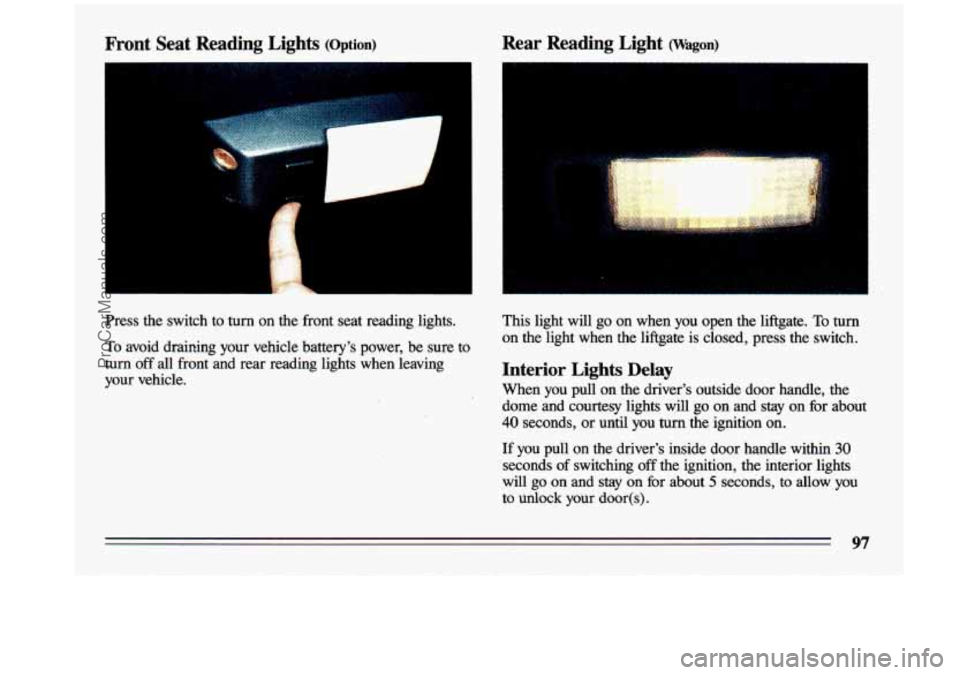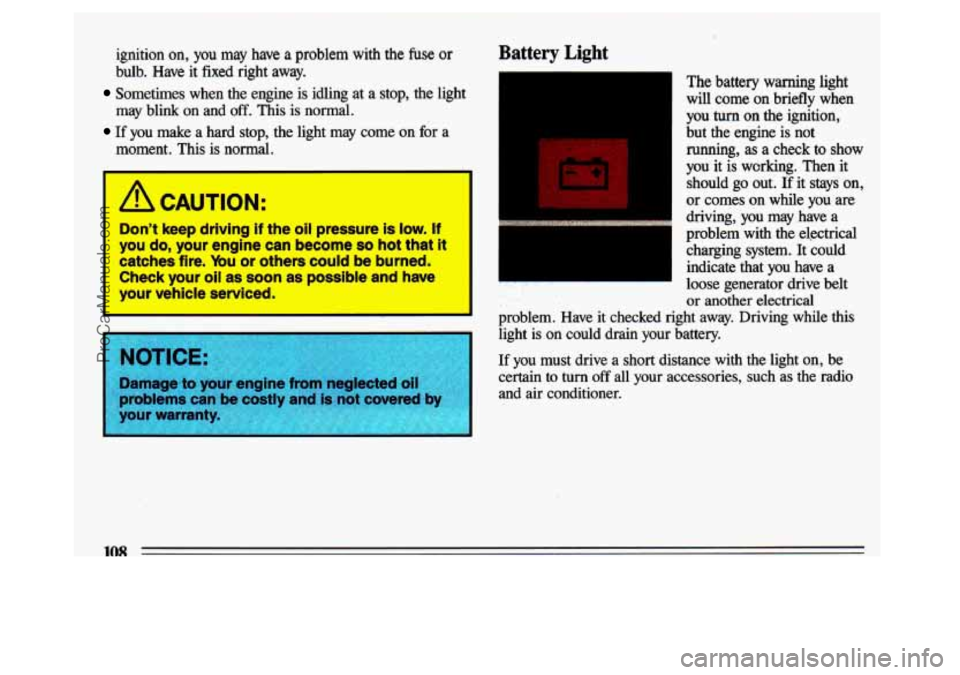1993 BUICK CENTURY battery
[x] Cancel search: batteryPage 14 of 324

I
Vehicle Symbols
These are some of the symbols you will find on your vehicle.
For example,
these symbols
are used on an
original battery:
POSSIBLE A
CAUTION
INJURY
PROTECT EYES BY
SHIELDING
CAUSTIC
ACID COULD CAUSE
BATTERY
BURNS AVOID
SPARKS
OR
FLAMES
SPARK
OR ,111,
COULD FLAME
EXPLODE BATTERY
These symbols
are important
for. you and
your passengers
whenever your
vehicle
is
driven:
DOOR LOCK
UNLOCK
FASTEN SEAT
4
BELTS
POWER
WINDOW
These symbols
have
to do with
your lights:
SIGNALS e3
TURN
WARNING
A
HAZARD
FLASHER
HIGH BEAM
OR =, =o
FOG LAMPS # 0
These symbols
are on some
of
your controls:
WINDSHIELD ' ' ' 0- 0-
WIPER &
WASHER
t0 @e4 i
WINDSHIELD=
WASHER I
wlNDsHIELDw DEFROSTER
WINDOW
@
REAR
DEFOGGER
VENTILATING FAN
HEADLAMP
-
WIPER -
WASHER zQ
Thes, ,ymbols
are used on
warning and indicator lights:
COOLANT F-
ENGINE
TEMP
--
CHARGING I-1
BATTERY SYSTEM
FUEL
ENGINE OIL wb
PRESSURE
TEMP
OIL &
ANTILOCK BRAKE (i)
Here are some
other symbols
you may see:
FUSE
RADIO
k
VOLUME a
CONDITIONING AIR a
HATCHBACK e
TRUNK
RELEASE
SPEAKER
b
ProCarManuals.com
Page 41 of 324

A CAUTION:
Don’t attach anything to the steering wheel
pad.
It might injure the driver if the air bag
inflates.
The air bag
is designed to inflate only once.
After
it inflates, you’ll need some new parts for
your air bag system. If you
don’t get them, the
air bag system won’t be there
to help protect
you
in another crash. A new system will
include the air bag module and possibly other
parts. The service manual has information
about the need
to replace other parts.
Let only qualified technicians work
on your air
bag system. Improper service can mean that
your air bag system won’t work properly. See
your dealer for service.
Servicing Your Buick with the Air Bag
System
Please tell or remind anyone who works on your Buick
that it has
the air bag system. There are parts of the air
bag system in several places around your vehicle.
You
don’t want the system to inflate while someone is
working on your vehicle. The air bag system does not need regular maintenance. Your Buick
dealer and the
1993 Century Service Manual have information about the
air bag system, including repair
or disposal.
A CAUTION:
For up to 2 minutes after the ignition key is
turned
off and the battery disconnected, an air
bag can still inflate during improper service.
Yonn
can be injured if you are close to an air bag whc..
it inflates. Be sure to follow the proper service
procedures.
I
When electrical work is done under the hood or inside
your vehicle, the ignition should be
in “Lock” if possible.
Avoid wires wrapped with yellow tape, or yellow
connectors. They are probably part of the air bag system.
But if the ignition has to be on for electrical work, or if
the steering column is
to be disassembled, the air bag
system must be disconnected.
To do this:
Turn off the ignition.
Remove the SIR (air bag) fuse (see “Fuses & Circuit
Disconnect the yellow connector at the base of the
Breakers” in the Index).
steering column.
3V
ProCarManuals.com
Page 69 of 324

Should interference to this system occur, try this:
Check to determine if battery replacement is necessary. See
the instructions on battery replacement later in this section.
Check the distance. You may be too far from your
vehicle. This product has
a maximum range.
Check the location. Other vehicles or objects may be
blocking the signal.
See your Buick dealer or a qualified technician for
service.
Changes or modifications to this system by other than an
authorized service facility could void authorization to use
this equipment.
Operation
The driver’s door will unlock and the interior lights will
go on when “UNLOCK’ is pressed. If pressed again
within five seconds, all doors will unlock. The interior
lights will
go out after 40 seconds or when you turn on
the ignition.
All doors will lock when “DOOR” is pressed.
The trunk or liftgate will unlock when the opened trunk
symbol is pressed, but only when the transaxle is in
“P”
(Park). On the wagon the ignition must also be in the
“Off” position.
Matching Transmitter(s) to Your Vehicle
Each key chain transmitter is coded to prevent another
transmitter from unlocking your vehicle.
If a transmitter
is lost or stolen, a replacement can be purchased through
your dealer. Remember to bring the remaining
transmitter with you when you
go to your dealer. When
the dealer matches the replacement transmitter to your
vehicle, the remaining transmitter must also be matched. Once the new transmitter is coded, the lost transmitter
will not unlock your vehicle.
You can match a transmitter to as many different vehicles
as you own, provided they are equipped with
exactly the
same model system.
(General Motors offers several
different models of these systems on their vehicles.) Each
vehicle can have only two transmitters matched to it. See
your dealer to match transmitters to another vehicle.
Battery Replacement
Under normal use, the batteries in your key chain
transmitter should last about
two years.
You can tell the batteries are weak if the transmitter won’t
work at the normal range in any location.
If you have to
get
close to your vehicle before the transmitter works, it’s
probably time to change the batteries.
ProCarManuals.com
Page 70 of 324

For battery replacement use
two DuracelP batteries,
type
DL-2016, or a similar
type.
To replace batteries:
1. Remove the screw from the back cover.
2. Lift off the front cover, bottom half fEstst,
3. Remove and replace the batteries.. Put them in
following the diagram under the batteries on the inside
of the cover.
tightly,
so water won't get in. Replace the screw in the
back cover.
4. Replace the front cover. Make sure the cover is on
5. Check the transmitter operation.
68
ProCarManuals.com
Page 77 of 324

4. If your engine still won’t start (or starts but then
stops), it could be flooded with too much gasoline.
Try pushing your accelerator pedal all the way to the
floor and holding it there as you hold the key in
“Start” for about three seconds. If the car starts
briefly but then stops again, do the same thing, but
this time keep the pedal down for five or six seconds.
This clears the extra gasoline from the engine.
To start your 3300 V6 (Code N) engine:
1. Don’t push the accelerator pedal before starting your
engine. In some other vehicles you might need to do
this, but because of yourwehicle’s computer systems,
you don’t.
starts, let go of the key. The idle
speed will go down
as your engine gets warm.
2. Turn your ignition key to “Start? When the engine
3. If it doesn’t start right away, push the accelerator pedal
about one-quarter of the way down while you turn the
key to “Start;’ Do
this until the engine starts. As soon
as it does, let go of the key and the accelerator pedal.
seconds-at a time will cause your battery to b
drained much sooner. And the excessive hea
can damage your starter motor,
4. If your engine still won’t start (or starts but then
stops), it could be flooded with too much gasoline.
Try pushing your accelerator pedal all the way to the
floor and holding it there as you hold the key in
“Start” for about
15 seconds. This clears the extra
gasoline from the engine. Turn the ignition
key to
“Off’ Wait 10 seconds, then repeat Step 3.
I
I
75
ProCarManuals.com
Page 99 of 324

Front Seat Reading Lights (Option) Rear Reading Light (Wagon)
I
Press the switch to turn on the front seat reading lights.
To avoid drair.ing your vehicle battery's power,
be sure to
turn off all front and rear reading lights when leaving
your vehicle. This light will go
on when you open the liftgate. To turn
on
the light when the liftgate is closed, press the switch.
Interior Lights Delay
When you pull on the driver's outside door handle, the
dome and courtesy lights will go on and stay on for about
40 seconds, or until you turn the ignition on.
If you pull on the driver's inside door handle within 30
seconds of switching off the ignition, the interior lights
will go
on and stay on for about 5 seconds, to allow you
to unlock your door(s).
97
ProCarManuals.com
Page 110 of 324

ignition on, you may have a problem with the fuse or
bulb. Have it fixed right away.
Sometimes when the engine is idling at a stop, the light
may blink on and
off. This is normal.
If you make a hard stop, the light may come on for a
moment.
This is normal.
1 A CAUTIONS
Don't keep driving if the oil pmssure is low. If
you do, your engine can become QO hot that It
catches flm. "ybu or others could be burned.
Check wur oil as soon as possible end have
your t rlcle senrlced.
I
Battery Light
The battery warning light
will come on briefly when
you
turn on the ignition,
but the engine is not
running, as a check to
show
you it is wcrking. Then it
should go out. If it stays on,
or comes on while you are
driving, you may have a
problem with the electrical
charging system. It could
indicate that you have a
or another electrical
. ., . loose generator drive belt
problem. Have it checked right away. Driving while this light is on could drain your battery.
If you must drive a short distance with the light on, be
certain to
turn off all your accessories, such as the radio
and air conditioner.
108
ProCarManuals.com
Page 111 of 324

Volts Gage (Option)
When your engine is not
running, but
the ignition is
on (in the “Run” position),
the gage shows your
battery’s state of charge
in
DC volts. When the engine
is running, the gage shows
the condition of the
charging system. Readings
between the red warning
zones indicate the normal
operating range.
Readings in either red
warning zone indicate a possible problem in the electrical
system. Have your vehicle serviced immediately.
Brake System Warning Light
Your Buick‘s hydraulic
brake system is divided into
two parts. If one part isn’t working, the other part can still work and stop you. For
good braking, though, you
need both parts working
well.
If the warning light
goes on, there could be a
brake problem. Have your
brake system inspected right away.
This light should come on
as you start the vehicle. If it doesn’t come on then, have it
fixed
so it will be ready to warn you if there’s a problem.
This light will also come on when you set your parking
brake, and will stay on if your parking brake doesn’t release
fully. If it stays on after your parking brake is
fully released, it means you have a brake problem.
If the light comes on while driving, pull
off the road and
stop carefully.
You may notice that the pedal is harder to
push. Or, the pedal may go closer to -the floor. It may take
longer to stop. If the light is still on, have the vehicle towed
for service. (See “Towing Your Buick” in the Index.)
109
ProCarManuals.com